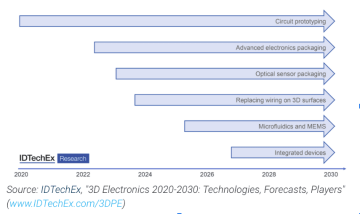AME - a new concept in electronics manufacturing
Additively Manufactured Electronics (AME) or additively manufactured electronics is an emerging process that takes the field of printed electronics to a new dimension. Printing both structural materials and conductive traces brings huge advantages, especially great design freedom, rapid development and more compact end devices. In this article, we will introduce the two basic categories of AME, which are referred to as "fully additive" and "printing on 3D surfaces". Both offer a range of application opportunities that IDTechEx expects to develop over the next decade.
Fully additive electronics manufacturing
When both structural and electronic components are printed through 3D printing, this manufacturing process is considered "fully additive". This manufacturing approach provides great freedom, as there are virtually no restrictions on how the conductive traces will be distributed in the printed structure. This makes it easy to integrate "specialties" such as spiral antennas, integrated capacitors or ramp vias that are difficult or in some cases impossible to fabricate using conventional methods. In addition, SMD (Surface Mount Device) components can also be incorporated into the structure if required.
With fully additive manufacturing, electronics developers can handle circuit prototyping much more quickly because they can produce complex multilayer circuits in-house much faster than the current practice of sending designs to an external prototyping center and waiting for their conclusions.
Printing on 3D surfaces
Additively manufactured electronics can also involve applying electronic functions to existing 3D surfaces. Conductive tracks could be printed onto an injection-moulded plastic part, for example, using specialised methods such as aerosol printing or material extrusion. Durability and robustness can then be further improved by printing a dielectric material on top. In addition, SMD components can be mounted on the 3D surface using pick-and-place and conductive adhesives. This approach is very promising for assembling electronics into larger parts where the printing time of structural plastic would be prohibitive.
A key target application for this approach is to replace wiring in consumer products, vehicles, and even aircraft. Currently, installing cabling is a difficult and time-consuming job that must be done by hand, and therefore has the potential for errors and subsequent short circuits if wires rub together. Printing cabling directly onto a 3D plastic surface allows the entire process to be automated and increases durability, as the conductive traces are ultimately embedded in the dielectric material.
Incorporation of microfluidics and photonics
As additive manufacturing of electronics becomes more prevalent in a variety of industries, it is likely that an increasing number of features will also become available in AME. It can therefore be expected that this could soon include microfluidics with electrical sensors, piezoelectric actuators and even other MEMS components embeddable via 3D printing. Other promising applications are Lab-on-a-chip for medical diagnostics or perhaps wearable sensors for sweat analysis.
Additively manufactured electronics are also compatible with photonic structures, although the printing resolution of both dielectric and conductive elements will need to be improved. Examples of potential applications include photonic sensors in which the refractive index of the optical path is varied by temperature or gas absorption, or optoelectronic components.
Expected practical applications
Given the current stage of development of both electronics and 3D printing, and other requirements such as manufacturing throughput and resolution, AME can only be expected to become more widespread around 2030. While circuit prototyping via 3D printing is already starting to be experimented with, the development of entire integrated devices with many different functions will be very challenging and require higher quality components than are currently available.

If you are interested in the topic of additively manufactured electronics, you can find more information in the IDTechEx report „3D Electronics 2020-2030: Technologies, Forecasts, Players“. For a complete list of IDTechEx reports on 3D printing and printed electronics, visit www.IDTechEx.com.